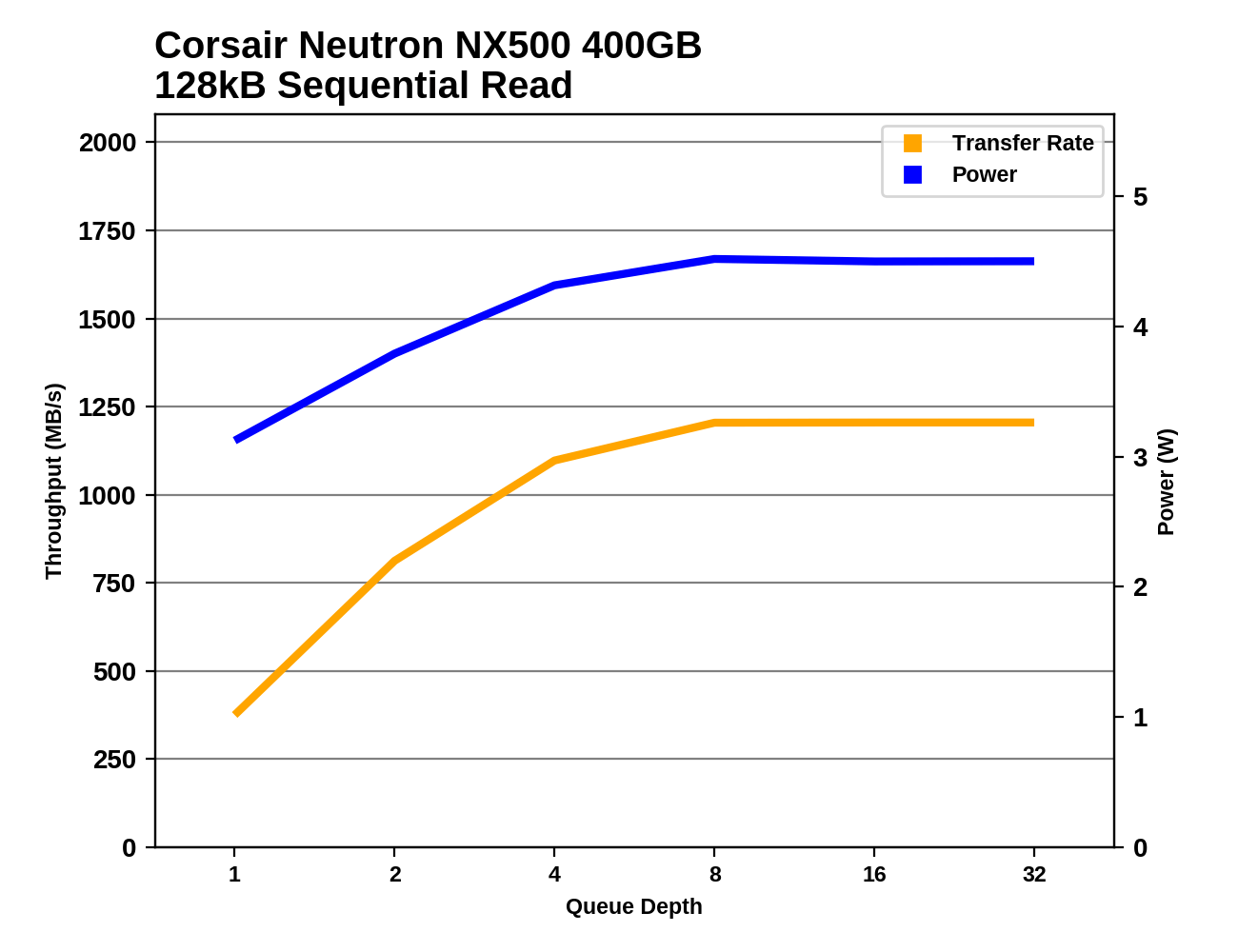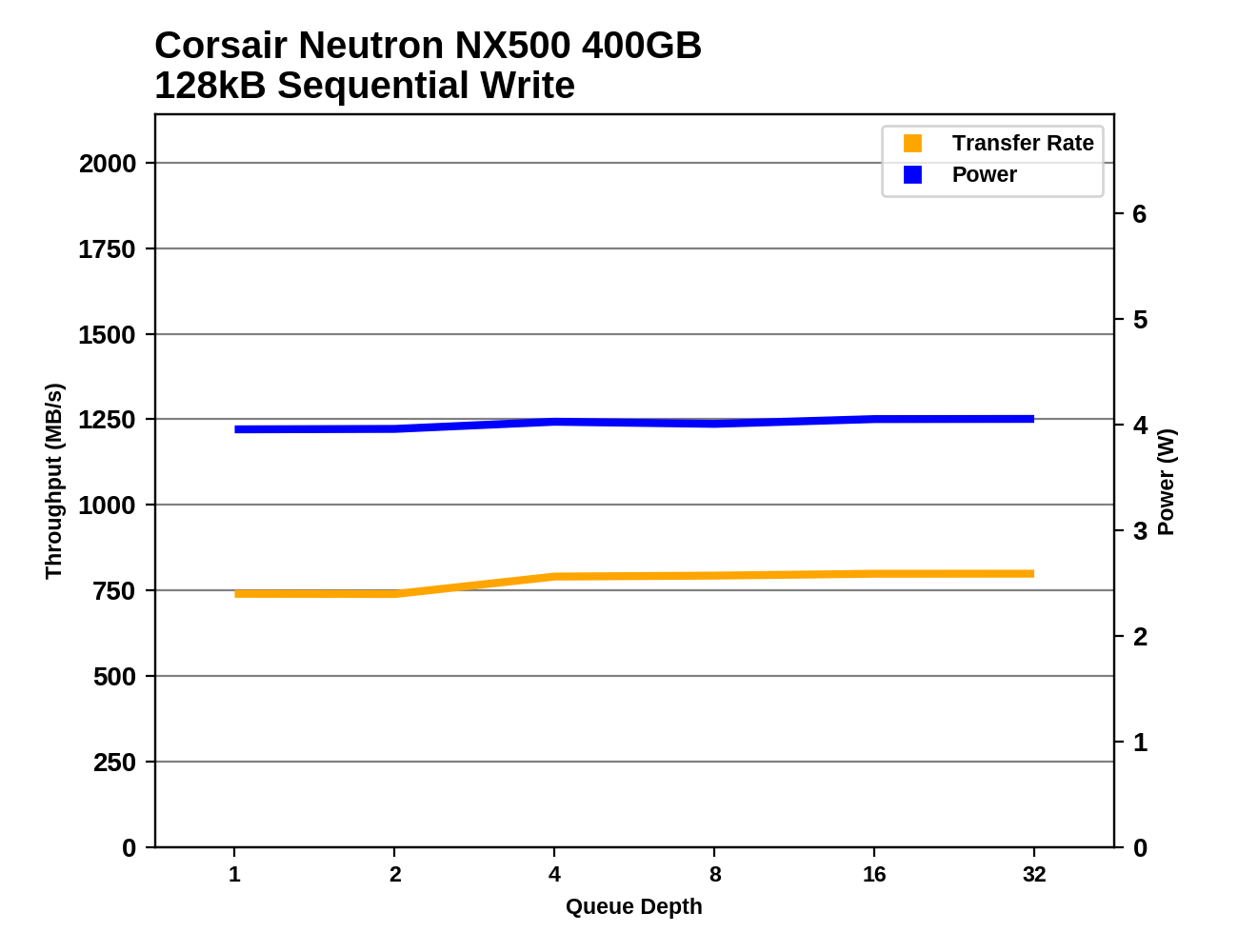The Corsair Neutron NX500 (400GB) PCIe SSD Review: Big Card, Big Pricetag
by Billy Tallis on August 16, 2017 10:00 AM ESTSequential Read Performance
Our first test of sequential read performance uses short bursts of 128MB, issued as 128kB operations with no queuing. The test averages performance across eight bursts for a total of 1GB of data transferred from a drive containing 16GB of data. Between each burst the drive is given enough idle time to keep the overall duty cycle at 20%.

The QD1 burst sequential read speed of the Corsair Neutron NX500 is a bit slower than the Patriot Hellfire, and quite a bit slower than the Plextor M8Pe. The Samsung NVMe drives are in a completely different league with QD1 read speeds more than twice as fast as any competitor.
Our test of sustained sequential reads uses queue depths from 1 to 32, with the performance and power scores computed as the average of QD1, QD2 and QD4. Each queue depth is tested for up to one minute or 32GB transferred, from a drive containing 64GB of data.

In the longer test that includes some higher queue depths, the NX500's sequential read speed is respectable and basically tied for the fastest non-Samsung drive in the bunch. It is also clearly faster than the other two Phison E7 drives.

The power efficiency of the NX500 during sequential reads is the best among the NVMe SSDs using planar NAND, and the other two Phison E7 drives follow the NX500 in the rankings. Samsung and Toshiba's 3D NAND NVMe drives offer much higher power efficiency.
 |
|||||||||
From QD1 speeds barely faster than a SATA link and half as fast as most NVMe competition, the NX500 eventually scales up to a decent saturation speed of around 1.2GB/s at QD8 or higher. Unfortunately, Samsung delivers better performance than this even at QD1, though the 960 EVO only barely so, and the 500GB version might not be quite as fast.
Sequential Write Performance
Our test of sequential write burst performance is structured identically to the sequential read burst performance test save for the direction of the data transfer. Each burst writes 128MB as 128kB operations issued at QD1, for a total of 1GB of data written to a drive containing 16GB of data.

The Corsair Neutron NX500's burst sequential write speed is the slowest of the three Phison E7 drives, but only barely and the performance is still decent for a planar NAND drive.
Our test of sustained sequential writes is structured identically to our sustained sequential read test, save for the direction of the data transfers. Queue depths range from 1 to 32 and each queue depth is tested for up to one minute or 32GB, followed by up to one minute of idle time for the drive to cool off and perform garbage collection. The test is confined to a 64GB span of the drive.

With a longer test, the Phison E7 drives hold on to their rankings though the NX500 is still the slowest of the three by a hair. Samsung's drives offer far higher sequential write speeds, but the rest of the competitors are clearly slower than the NX500.

The NX500's power efficiency during sequential writes is a bit worse than the Patriot Hellfire, but otherwise it is only beat by Samsung's NVMe drives. The next most efficient drive is the Toshiba XG5, which like Samsung's drives has the benefit of 3D NAND.
 |
|||||||||
The performance and power consumption of the Corsair Neutron NX500 during sequential writes barely changes with queue depth. The Samsung 960 EVO 1TB is more than twice as fast at QD2 or higher, so it is a very safe bet that even the 500GB version of the 960 EVO would have a significant advantage over the NX500 here.










45 Comments
View All Comments
shabby - Wednesday, August 16, 2017 - link
According to toms review the 500gb one still does 2gb/s read/write at qd1, nothing touches it.Ratman6161 - Wednesday, August 16, 2017 - link
Yes, according to Tom's and others, the 500 GB 960 EVO is still the drive to have in its size class - which is why I bought one. On the other hand the 256 GB 960 EVO doesn't stand up against the competition like the 500 and up drives do. So, when comparing these drives with an eye to actually purchasing one, its a great idea to find reviews of the actual size you are looking at and comparing against other like sized drives.mapesdhs - Thursday, August 17, 2017 - link
Trouble with the EVO is when its cache is full it can't take the heavy writes, and its random & steady state performance are not that great. They're good enough (I bought a 250GB for my brother), but the Pro is way better, and the 950 Pro is better aswell.CrazyElf - Wednesday, August 16, 2017 - link
This doesn't justify the premium over SATA SSDs.Unlike say, the Samsung SSD 960 series or the Intel SSD 750, which do have something to offer, especially when it comes to sequential performance, these drives really struggle to justify the premium.
Yeah it seems increasingly like Intel (SSD 750 dominates sustained writes on 4k) and Samsung (dominates most other benchmarks).
I mean, products like Optane are expensive, but at least they have some premium (ex: the good 4k performance).
versesuvius - Wednesday, August 16, 2017 - link
Corsair expects to be paid higher for whatever it puts together no matter what. The same is true with Cooler Master and Logitech. For each single one of their products there is an equivalent product on the market that is higher in quality and performance and considerably lower in price.valinor89 - Wednesday, August 16, 2017 - link
I don't know about Cooler Master, but logitech sells plenty of cheap stuff and some products have very good prices for what they offer. The G502 was quite the revolution in perf/price and I find my G610 to have very good quality compared to Corsais Oferings.Bullwinkle J Moose - Wednesday, August 16, 2017 - link
With PCIe lane counts coming up, I hope to see Samsung and Intel start using themWith a full 16 lanes being used, benchmarking can finally change along with the SSD processors/firmware
Intel may take the lead with xpoint initially, but with the ability to run several simultaneous tests on an SSD max iop / mixed mode, copy/paste, 100GB uncompressed read speed, 100GB uncompressed write as well as torture tests as the onboard processors finally catch up to the lane counts, I think Samsung may yet have a few surprises for xpoint
4 lanes ain't gonna cut it for my 16 core cpu
Get with the times!
Ratman6161 - Wednesday, August 16, 2017 - link
No matter how many PCIe lanes your ThreadRipper CPU has available (assume that's what you are talking about since you say 16 core) the spec for NVMe is still x4Billy Tallis - Wednesday, August 16, 2017 - link
NVMe has nothing to say about PCIe lane counts. You're probably thinking about the M.2 connector, but that is hardly the only way to connect a PCIe SSD.hlm - Wednesday, August 16, 2017 - link
Yes, it is when NVMe is used through U.2 and M.2 that you get four-lane PCIe. When used through SATA Express, NVMe is stuck with two-lane PCIe.